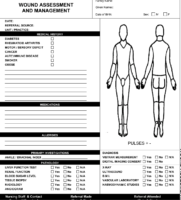Wound Assessment- Past and Current Wound History
Obviously, when you are assessing a patient for the first time it is important to ask about their current wound and the circumstances behind it. Equally important is to ask about their history of previous wounds in terms of what treatments were used, how long it took to heal the wound and whether there were any complications.
The following are some suggested questions to ask the client about their wound history:
How long have you had the wound?
Wounds related to trauma will usually heal quite quickly, provided the patient does not have any health problems that might impact healing (i.e. diabetes). Wounds that develop slowly tend to heal more slowly, and may signify an underlying health problem. For example, a wound that develops slowly on the lower leg may be caused by venous insufficiency and may take a long time to heal. This knowledge may help you to determine what therapy may be needed and may also guide testing and referrals.
Have you had any tests done since developing the wound?
There are a variety of tests that can shed light on the patient’s health status and/or wound type and healing potential. For example, blood tests may reveal poorly controlled diabetes (HgbA1C), anemia (CBC), issues with oxygenation (pulmonary function tests, oxygen saturation), heart disease (high blood pressure, high serum cholesterol), poor nutrition (protein and albumin levels) or the presence of infection in the wound (wound cultures).
Has your wound changed at all?
Asking whether the wound has changed in size and/or depth can provide information regarding the efficacy of the current therapy regimen, presence of complicating factors and whether you need to try something new. This information may also guide referrals and testing.
Do you have any pain associated with your wound?
Pain (or lack of pain) can provide clues about wound etiology. Patients with arterial insufficiency wounds often have pain, and the pain changes with activity and positioning. Patients with wounds caused by venous insufficiency may have pain related to swelling that may be relieved by elevation, rest and/or compression. Patients who have no pain may have nerve damage caused by diabetic neuropathy or another problem affecting sensation. Patients who have pain that is poorly controlled, especially if the pain is of long duration may suffer from depression that may affect adherence. Information regarding pain can supply a lot of important clues.
Have you been on antibiotics?
Ask the patient what antibiotic(s) they have been on and the route by which the antibiotic was administered. Patients who have been on antibiotics for a long time with no change in their wound may have a resistance microorganism. They may also have been prescribed the wrong antibiotic. Having this information can help you determine whether the wound should be cultured and guide further assessment.
Have you had any wounds previous to this one?
It is important to gather information about past wounds and their healing history. Patients who healed quickly in the past whose health history has not changed will likely heal quickly again. On the other hand, patients with underlying health problems who had issues with wound healing previously will likely follow the same path with their current wound. These patients will require all of your talent and skills to heal. Obtaining written or recorded notes related to previous wounds may help you determine a course of action for the current wound.
Read additional blog posts about wound assessment and documentation.
As you can see, obtaining a current and thorough wound history is an important component of wound assessment. If you are interested in learning more about wound certification, please visit Wound Educators for more information.
Sources:
Myers, B. (2008). Wound Management: Principles and Practice. 2nd edition. Pearson Prentice Hall. Upper Saddle River, New Jersey. pg. 44-45.
Eagle, M (2009). Wound assessment: The patient and the wound. Wounds International. Wound Essentials volume 4. pg. 14-18. http://www.woundsinternational.com/pdf/content_54.pdf


Taking the time to get the story about a patient’s wound history is imperative, it truly does set the benchmark for subsequent treatment. If more staff were knowledgeable of the importance of this crucial step, many health care dollars would be saved, and in the long run less time would be spent.
Thank you for your post.
Delfina Prest
Nova Scotia
I totally agree Delfina. Thanks for your input!